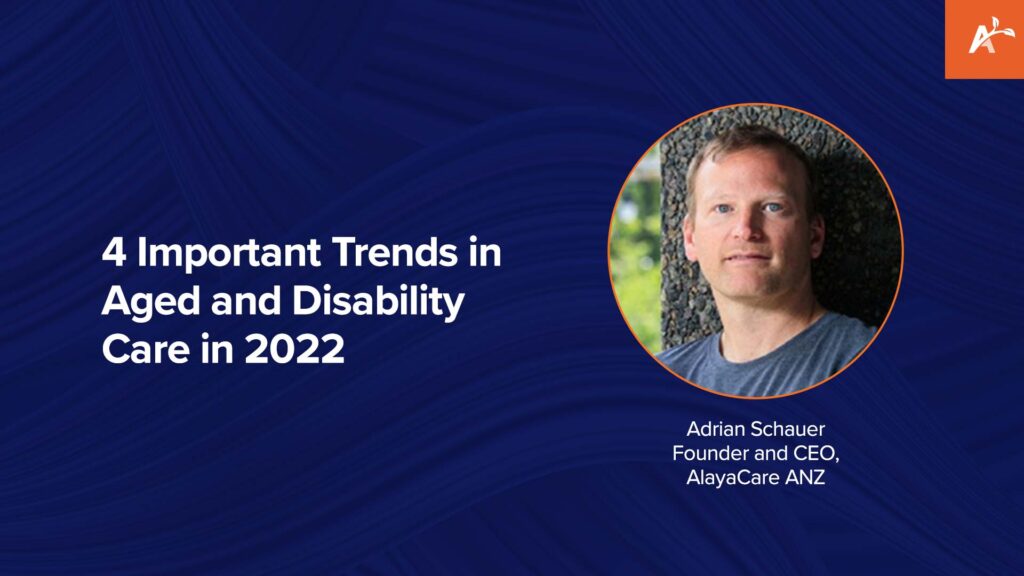Blog
Trends for aged and disability care in 2022

Will history judge 2022 to be the year that our health systems built back better? And that “better” accelerated the shift of care to be more available in the home? Or will it be a year where capacity constraints mean we missed a generational opportunity to transform how our societies deliver home-based care in the wake of COVID-19?
While the answer likely lies somewhere in the middle, I want to highlight a few future trends that have not materialised yet, despite the growing hype.
As a technologist, I know that I have a bias in the role that software will play in the transformation of our industry. Still, certain themes are hard to ignore. The Internet-of-things (IoT), with peripherals connected by Bluetooth, is showing signs of being leap-frogged by smartphones and smartwatches, which now offer an increasing number of biometrics and surveillance services.
While data science continues to grow in importance, sometimes a simple linear model gives a good enough prediction with a more explainable result compared with a black-box artificial intelligence (AI) solution. We still trust the intermediaries with our health data; this reduces the need for block-chain based solutions for health transactions. Don’t expect an ICO from your health plan any time soon.
Now, let’s look at some of the most important themes for 2022, and how technology can help guide us to a better outcome. In many cases, whether these trends actually become reality will help determine whether we can rebuild our health systems around the client and their home setting.
Labour market pressures will force innovation in employment models
As in the software development space, when labour demand outstrips supply, the industry starts to satisfy the employee first and the customer second. I believe that the previous 150 years of this industry will be viewed as the era of centralisation, as care moved out of the home and brought the client to the doctor/nurse/therapist/care facility. The clients organised around the healthcare provider’s location not schedule.
While home healthcare has been making big strides towards care meeting the client at their location (ie: home) on their schedule, we may need to settle for the client choosing the location and the care provider picking the time. Some technology implications:
- Friction will be taken out of the care coordination experience for the client, with digital tools allowing clients to express their timing preferences but ultimately settling for giving them visibility, not control.
- Schedule and route optimisation tools will rise to meet the need for care worker-centric scheduling.
- In a journey towards being employers of choice for care workers, more providers will move towards guaranteed hours and/or full-time employment models, leveraging subcontracting through tools like AlayaMarket to fill any gaps.
Public funds will rush into home healthcare, finally pushing rates up
Policy makers have increasingly realised that voter preference for care in their home is a platform they can (and should) run on, similar to marketers of health plans. They are no longer able to ignore the shortage of care workers and so will accept overall rate increases to attract more workers to the sector. Technology will support this trend, as rate increases will often come with strings attached – e.g., if I’m giving you more money, show me the value I’m getting for it. Technology will support this by:
- Enabling more outcome-based reimbursement schemes.
- Increasing the focus on health outcomes, meaning more structured data collected at the point-of-care, and better tools to aggregate that data into proof (or proxies of proof) of health outcomes.
- Prioritising the experience of carers on the platform.
Digital tools will support greater participation of the client and their family carers in the circle of care
As with the sourdough you started in the summer of 2020, we will find ourselves doing more with increasingly democratised tools and knowledge. Baking bread at home was a choice we made, helping our kids participate in virtual school while trying to do our day jobs is a choice that was made for us. In the care in the home space, necessity will be the mother of invention.
- Telehealth will rise, with P2P2C models gaining traction. Yes, I made up that acronym. By this I mean that the formal care Provider will instruct the informal care Provider on how to provide hands-on-care for the Client. The technology is there, and reimbursement models will need to evolve to support this modality.
- Tools for care worker education and empowerment will gain traction, as informal carers will play an increasingly formalised role in patient care.
- Messaging tools tying the care team together will gain more traction.
Public perception will adjust to COVID being an endemic threat, albeit an ever-reducing one
When an acute threat produces risk-reduction rituals, they tend to be sticky. Historical events in combination with rapid advances in scientific knowledge about causes and prevention trigger significant changes in public health.
Which of our public health measures adopted during the pandemic will fade in 2022? Which will remain? And what does that mean for the delivery of care? As vaccination rates continue to increase and treatments for COVID improve, some public health measures will lose their justification when balanced against other health risks. How will this play out in the delivery of care?
- COVID-19 symptom screening tools are likely to remain in place. Risk reduction habits are sticky.
- Vaccination trackers will be ubiquitous and then irrelevant as vaccine mandates hit most every market.
- Contact tracing tools will remain and may broaden to include other infectious diseases.
As a leading provider of software to the home healthcare industry across multiple markets, we will continue to watch these trends and do our best to deliver solutions that help our customers thrive amidst these evolutions.
These predictions guide our roadmap. This time last year I predicted that in 2021:
Preference for ageing in the home will persist
We will see the rise of caregiving as a career
Care organisations will accelerate the shift from technology-enabled to technology-centric, and
Improved systems will be implemented to deal with persistent change
In response, we invested heavily to develop enhancements across the care worker mobile app, improvements in our scheduling tools, a major overhaul of our family portal, a new billing and document collation framework, more flexible Visit Verification tools, secure messaging tools, a new data exploration package, a new medication management module, and a new learning management system (LMS).
In the residential space, we have continued to make enhancements to our residential clinical module including the Chart Revamp, developed framework for Transition to Aged Care Web Services, and progressed to Beta for our AlayaCare Residential finance and back-office module.
We consider it an honour to help the aged and disability care industry realise its potential for good and we look forward to continuing to work alongside our clients in 2022 to deliver better outcomes.
To learn more about how AlayaCare can propel your organisation into the future and adapt to these emerging trends, Contact us today.







